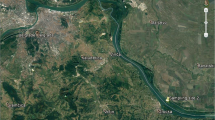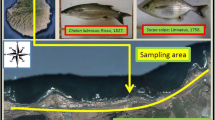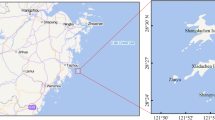Abstract
This study aimed to evaluate the bioaccumulation of heavy metals (copper, zinc, and lead) and chemical compositions (fat, protein, moisture, and ash) in the Parastromateus niger muscle of the Oman Sea in pre-monsoon and post-monsoon. An atomic absorption spectrophotometer was used to determine heavy metal concentrations in fish muscle tissue. Chemical composition contents were measured using the Association of Official Analytical Chemists (AOAC) methods. Zinc was the most abundant heavy metal in two seasons (0.077 ± 0.005 μg/g), followed by copper (0.033 ± 0.005 μg/g) and lead (0.015 ± 0.005 μg/g). The mean concentrations of all heavy metals of muscle in pre-monsoon were higher than in post-monsoon. The concentrations of Cu, Zn, and Pb were lower than the maximum permissible limits (MPL) of international standards for human consumption established by FAO, FAO/WHO, WHO, and MAFF. The protein and fat content in fish muscle collected in pre-monsoon was higher than in post-monsoon. A significant difference between protein, fat, moisture, and ash values was recorded in two seasons (P < 0.05). The human health risk of heavy metals was evaluated according to the United States Environmental Protection Agency (USEPA) standards. The estimated daily intake (EDI) of each heavy metal in two seasons was lower than the tolerable daily intake (TDI). THQ (target hazard quotient) and TTHQ (total target hazard quotient) values were lower than the threshold limit of 1.0, indicating a non-carcinogenic risk for consumers. TR (target carcinogenic risk) value for Pb was much lower than the unacceptable risk level (10−4); therefore, the consumption of muscles of Parastromateus niger did not significantly pose a human health risk.


Similar content being viewed by others
Data Availability
The datasets generated and analyzed during the course of this study are available on request.
References
FAO (Food and Agriculture Organization) (2016) The state of world Fisheries and aquaculture 2016. In: Contributing to food security and nutrition for all, Rome
Sroy S, Arnaud E, Servent A, In S, Avallone S (2021) Nutritional benefits and heavy metal contents of freshwater fish species from Tonle Sap Lake with SAIN and LIM nutritional score. J Food Compost Anal 96:103731. https://doi.org/10.1016/j.jfca.2020.103731
Milićević T, Romanić SH, Popović A, Mustać B, Đinović-Stojanović J, Jovanović G, Relić D (2022) Human health risks and benefits assessment based on OCPs, PCBs, toxic elements and fatty acids in the pelagic fish species from the Adriatic Sea, Chemosphere 287. Part 1:132068. https://doi.org/10.1016/j.chemosphere.2021.132068
Petricorena ZC (2014) chemical composition of fish and fishery products. In: Cheung P (ed) Handbook of food chemistry. Springer, Berlin, Heidelberg. https://doi.org/10.1007/978-3-642-41609-5_12-1
Ahmed I, Jan K, Fatma S, Dawood MAO (2022) Muscle proximate composition of various food fish species and their nutritional significance: A review. J Anim Physiol Anim Nutr 106:690–719. https://doi.org/10.1111/jpn.13711
Waterman JJ (2000) Composition and quality of fish. Torry Research Station, Edinburgh
Goldstein ED, Helser TE, Vollenweider JJ, Sreenivasan A, Sewall FF (2021) Rapid and reliable assessment of fish physiological condition for fisheries research and management using fourier transform near-infrared spectroscopy. Front Mar Sci 8:690934. https://doi.org/10.3389/fmars.2021.690934
Pyz-Lukasik R, Chalabis-Mazurek A, Gondek M (2020) Basic and functional nutrients in the muscle of fish: a review. Int J Food Prop 23(1):1941–1950. https://doi.org/10.1080/10942912.2020.1828457
Yu BJ, Wang XL, Dong KF, Xiao GX, Ma D (2020) Heavy metal concentrations in aquatic organisms (fishes, shrimp and crabs) and health risk assessment in China. Mar Pollut Bull 159:111505. https://doi.org/10.1016/j.marpolbul.2020.111505
Xia W, Chen L, Deng X, Liang G, Giesy JP, Rao Q, Zihao Wen Z, Wu Y, Chen J, Xie P (2019) Spatial and interspecies differences in concentrations of eight trace elements in wild freshwater fishes at different trophic levels from middle and eastern China. Sci Total Environ 672:883–892. https://doi.org/10.1016/j.scitotenv.2019.03.134
Lu J, Li A, Huang P (2017) Distribution, sources and contamination assessment of heavy metals in surface sediments of the South Yellow Sea and northern part of the East China Sea. Mar Pollut Bull 124:470–479. https://doi.org/10.1016/j.marpolbul.2017.07.007
El-Morshedi N, Alzahrani I, Kizilbash NA, Abdeen A, El-Shebbly AA, El-Berri A (2014) Effect of heavy metal pollutants on fish population in two Egyptian lakes. Int j adv Res 2(1):408–417
Sadeghi P, Loghmani M, Yousuf DJ, Taghizade Rahmat Abadi Z (2021) Ecological and human health risk assessment of trace element pollution in sediments and five important commercial fishes of the Oman Sea. Mar Pollut Bull 173:112962. https://doi.org/10.1016/j.marpolbul.2021.112962
van den Thillart G, van Ginneken V, Körner F, Heijmans R, van der Linden R, Gluvers A (2004) Endurance swimming of European eel. J Fish Biol 65:1–7. https://doi.org/10.1111/j.0022-1112.2004.00447.x
Authman MMN, Zaki MS, Khallaf EA, Abbas HH (2015) Use of fish as bio-indicator of the effects of heavy metals pollution. J Aquac Res Development 6:328. https://doi.org/10.4172/2155-9546.1000328
Green AJ, Planchart A (2018) The neurological toxicity of heavy metals: A fish perspective. Comp Biochem Physiol C Toxicol Pharmacol. 208:12–19. https://doi.org/10.1016/j.cbpc.2017.11.008
Velma V, Vutukuru SS, Tchounwou PB (2009) Ecotoxicology of hexavalent chromium in freshwater fish: a critical review. Rev Environ Health 24(2):129–145. https://doi.org/10.1515/reveh.2009.24.2.129
Sadeghi P, Kazerouni F, Savari A, Movahedinia A, Safahieh A, Ajdari D (2015) Application of biomarkers in epaulet grouper (Epinephelus stoliczkae) to assess chromium pollution in the Chabahar Bay and Gulf of Oman. Sci Total Environ 518:554–561. https://doi.org/10.1016/j.scitotenv.2015.03.017
Ge M, Liu G, Liu H, Liu Y (2020) Levels of metals in fish tissues of Liza haematocheila and Lateolabrax japonicus from the Yellow River Delta of China and risk assessment for consumers. Mar Pollut Bull 157:111286. https://doi.org/10.1016/j.marpolbul.2020.111286
Vetsis E, Kalantzi I, Pergantis SA, Kokokiris L, Karakassis I (2021) Metals in tissues of marine fish from the Thermaikos Gulf, Eastern Mediterranean Sea: detection of changes with trophic level. Mar Pollut Bull 173:113024. https://doi.org/10.1016/j.marpolbul.2021.113024
Secombes CJ, Ellis AE (2012) The immunology of teleost. In: Roberts RJ (ed) Fish pathology, vol 1. W.B. Saunders London, England, pp 133–150
Lin C, Chen J, Xu J, Li Y, Liu Y, Lin H (2022) Distribution and risk assessment of heavy metals in the economic fish of the Southern Fujian Province. Environ Toxicol Pharmacol 92:103834. https://doi.org/10.1016/j.etap.2022.103834
Goswami BN, Xavier PK (2004) Dynamics of internal interannual variability of indian summer monsoon in a GCM. J Geophys Res Atmos 110(D24). https://doi.org/10.1029/2005JD006042
Esmaeilzade Ashini A, Sadeghi P, Tootooni MM (2021) The effect of monsoon on chemical composition and bioaccumulation of heavy metals in Scomberomorus commerson, Lacepede 1800, from Oman. Sea Pollution 7(4):923–932. https://doi.org/10.22059/POLL.2021.325185.1111
Loghmani M, Tootooni MM, Sharifian S (2022) Risk assessment of trace element accumulation in two species of edible commercial fish Scomberoides commersonnianus and Cynoglossus arel from the northern waters of the Oman Sea. Mar Pollut Bull 174:113201. https://doi.org/10.1016/j.marpolbul.2021.113201
Reynolds RM (1993) Physical oceanography of the Gulf, Strait of Hormuz, and the Gulf of Oman: results from the Mitchell Expedition. Mar Pollut Bull 27:35–59. https://doi.org/10.1016/0025-326X(93)90007-7
Sadeghi P, Loghmani M, Afsa E (2019) Trace element concentrations, ecological and health risk assessment in sediment and marine fish Otolithes ruber in Oman Sea, Iran. Mar Pollut Bull 140:248–254. https://doi.org/10.1016/j.marpolbul.2019.01.048
Chandra S, Garg SK (2017) Pre and post-monsoon seasonal variation of some heavy metal pollution in sediments of river Gomti in the vicinity of Lucknow City, India. J Appl Sci Environ Manage 21(3):593–599. https://doi.org/10.4314/jasem.v21i3.21
Froese R, Pauly D (2021) FishBase. World Wide Web electronic publication. Version (08/2021). Available online at https://www.fishbase.org
AOAC (2005) Official methods of analysis, 18th edn. Association of Official Analytical Chemists, Washington DC
USEPA (1989) Risk assessment guidance for superfund. In: Human Health Evaluation Manual. EPA/540/1-89/002, vol. I. Office of Emergency and Remedial Response, Washington, DC.
Iran Fisheries Organization (IFO) (2020) In: Annual Iranian Fisheries Statistics 2014 and 2018. Fisheries Design and Program Office, Tehran, Iran, p 64
USEPA (U.S. Environmental Protection Agency) (2000) Guidance for assessing chemical contaminant data for use in fish advisories, Volume II. Risk assessment and fish consumption limits. (EPA 823-B-00-008). United States Environmental Protection Agency, Washington, DC
USEPA (2010) Risk-based concentration table. http://www2.epa.gov/risk/risk-based-screening-table-generic-tables
JECFA (Joint FAO/WHO Expert Committee on food Additives) (1982) Evaluation of certain food additives and contaminants. Twenty-sixth Report of the Joint FAO/WHO Expert Committee on Food Additives. WHO technical report series, no 683. World Health Organization, Geneva
EFSA (European Food Safety Authority) (2010) Scientific Opinion on lead in food. EFSA J 8(4):1570
Rahman MS, Molla AH, Saha N, Rahman A (2012) Study on heavy metals levels and its risk assessment in some edible fishes from Bangshi River, Savar, Dhaka, Bangladesh. Food Chem 134(4):1847–1854. https://doi.org/10.1016/j.foodchem.2012.03.099
Zaghloul GY, El-Din HME, Mohamedein LI, El-Moselhy KM (2022) Bio-accumulation and health risk assessment of heavy metals in different edible fish species from Hurghada City, Red Sea, Egypt. Environ Toxicol Pharmacol 95:103969. https://doi.org/10.1016/j.etap.2022.103969
Sadeghi P, Loghmani M, Frokhzad S (2020) Human health risk assessment of heavy metals via consumption of commercial marine fish (Thunnus albacares, Euthynnus affinis, and Katsuwonus pelamis) in Oman Sea. Environ Sci Pollut Res 27(13):14944–14952. https://doi.org/10.1007/s11356-020-07907-0
Arulkumar A, Paramasivam S, Rajaram R (2017) Toxic heavy metals in commercially important food fishes collected from Palk Bay Southeastern India. Mar Pollut Bull 119(1):454–459. https://doi.org/10.1016/j.marpolbul.2017.03.045
Turkmen M, Turkmen A, Tepe Y, Tore Y, Ates A (2009) Determination of metals in fish species from Aegean and Mediterranean seas. Food Chem 113:233–237. https://doi.org/10.1016/j.foodchem.2008.06.071
Adedeji OB, Okocha RC (2011) Assessment level of heavy metal in prawns (Macrobrachium macrobrachion) and water from Epe Lagoon. Adv Environ Biol 5(6):1342–1345
Cuajungco MP, Ramirez MS, Tolmasky ME (2022) Zinc: multidimensional effects on living organisms. Biomedicines 9(2):208. https://doi.org/10.3390/biomedicines9020208
Xu H, Yang H, Ge Q, Jiang Z, Wu Y, Yu Y, Han D, Cheng J (2021) Long-term study of heavy metal pollution in the northern Hangzhou Bay of China: Temporal and spatial distribution, contamination evaluation, and potential ecological risk. Environ Sci Pollut Res 28:10718–10733. https://doi.org/10.1007/s11356-020-11110-6
Farag AM, May T, Marty GD, Easton M, Harper DD, Little EE, Cleveland L (2006) The effect of chronic chromium exposure on the health of Chinook salmon (Oncorhynchus tshawytscha). Aquat Toxicol 76(3–4):246–257. https://doi.org/10.1016/j.aquatox.2005.09.011
Mishra AK, Mohanty B (2008) Acute toxicity impacts of hexavalent chromium on behavior and histopathology of gill, kidney and liver of the freshwater fish, Channa punctatus (Bloch). Environ Toxicol Phar 26:136–141. https://doi.org/10.1016/j.etap.2008.02.010
Makedonski L, Peycheva K, Stancheva M (2017) Determination of heavy metals in selected black sea fish species. Food Control 72(Part B):313–318. https://doi.org/10.1016/j.foodcont.2015.08.024
Mille T, Cresson P, Chouvelon T, Bustamante P, Brach-Papa C, Sandrine Rozuel BE, Bouchoucha M (2018) Trace metal concentrations in the muscle of seven marine species: Comparison between the Gulf of Lions (North-West Mediterranean Sea) and the Bay of Biscay (North-East Atlantic Ocean). Mar Pollut Bull 135:9–16. https://doi.org/10.1016/j.marpolbul.2018.05.051
Mehmood MA, Qadri H, Bhat RA, Rashid A, Ganie SA, Hamid Dar G, Rehman S (2019) Heavy metal contamination in two commercial fish species of a trans-Himalayan freshwater ecosystem. Environ Monit Assess 191:104. https://doi.org/10.1007/s10661-019-7245-2
Karunanidhi D, Aravinthasamy P, Subramani T, Chandrajith R, Janardhana Raju N, Antunes IMHR (2022) Provincial and seasonal influences on heavy metals in the Noyyal River of South India and their human health hazards. Environ Res 204(Part A):111998. https://doi.org/10.1016/j.envres.2021.111998
FAO (Food and Agriculture Organization) (1983) Compilation of legal limits for hazardous substances in fish and fishery products. FAO Fishery Circular No. 464:5–100
FAO/WHO Expert Committee on Food Additives (2011) Evaluation of certain food additives and contaminants: Seventy-third report of the Joint FAO/WHO Expert Committee on Food Additives. WHO Technical Report Series No 960:228
WHO (World Health Organization) (1989) Heavy metals environmental aspects. Environ Health Criteria. No. 85. Geneva, Switzerland
MAFF (Ministry of Agriculture, Fisheries and Food) (2000) Monitoring and surveillance of non-radioactive contaminants in the aquatic environment and activities regulating the disposal of wastes at sea, 1997. In: Aquatic environment monitoring report No. 52. Center for Environment, Fisheries and Aquatic Sciences, Lowestoft, UK
USEPA (United States Environmental Protection Agency) (2012) USEPA Regional Screening Level (RSL) summary table: November 2012
Saliu JK, Joy O, Catherine O (2007) Condition factor, fat and protein content of five fish species in Lekki Lagoon, Nigeria. Life Sci J 4:54–57. https://doi.org/10.7537/marslsj040407.12
Oliveira ER, Agostinho AA, Matsushita M (2003) Effect of biological variables and capture period on the proximate composition and fatty acid composition of the dorsal muscle tissue of Hypophthalmus edentatus (Spix, 1829). Braz Arch Biol Technol 46(1):105–114. https://doi.org/10.1590/S1516-89132003000100015
Lena GD, Nevigato T, Rampacci M, Casini I, Caproni R, Orban E (2016) Proximate composition and lipid profile of red mullet (Mullus barbatus) from two sites of the Tyrrhenian and Adriatic seas (Italy): a seasonal differentiation. J Food Compost Anal 45:121–129. https://doi.org/10.1016/j.jfca.2015.10.003
Eder EB, Lewis MN (2005) Proximate composition and energetic value of demersal and pelagic prey species from the SW Atlantic Ocean. Mar Ecol Prog Ser 291:43–52. https://doi.org/10.3354/meps291043
Holub DJ, Holub BJ (2004) Omega-3 fatty acids from fish oils and cardiovascular disease. Mol Cell Biochem 263(1):217–225. https://doi.org/10.1023/B:MCBI.0000041863.11248.8d
Zampelas A, Panagiotakos DB, Pitsavos C, Das UN, Chrysohoou C, Skoumas Y, Stefanadis C (2005) Fish consumption among healthy adults is associated with decreased levels of inflammatory markers related to cardiovascular disease: The ATTICA study. J Am Coll Cardiol 46:120–124. https://doi.org/10.1016/j.jacc.2005.03.048
Wu G (2020) Important roles of dietary taurine, creatine, carnosine, anserine and 4-hydroxyproline in human nutrition and health. Amino Acids 52:329–360. https://doi.org/10.1007/s00726-020-02823-6
El Oudiani S, Chetoui I, Darej C, Moujahed N (2019) Sex and seasonal variation in proximate composition and fatty acid profiles in Scomber scombrus (L. 1758) fillets from the Middle East Coast of Tunisia. Grasas Aceites 70(1):e285. https://doi.org/10.3989/gya.0235181
Kendler S, Tsoukalas D, Jakobsen AN, Zhang J, Asimakopoulos AG, Lerfall J (2023) Seasonal variation in chemical composition and contaminants in European plaice (Pleuronectes Platessa) originated from the west-coast of Norway. Food Chem 401:134155. https://doi.org/10.1016/j.foodchem.2022.134155
FAO (1999) World production of fish, crustaceans and mollusks by major fishing areas. Fisheries Information Data and Statistics Unit (FIDI). Fisheries Department, FAO Rome, p 33
Barua P, Pervez MA, Sarkar D, Sarker S (2012) Proximate biochemical composition of some commercial marine fishes from Bay of Bengal, Bangladesh. Mesopotamian Journal of Marine Sciences 27(1):59–66 https://www.iasj.net/iasj/download/a5fc0b59a3e016cb
Tulgar A, Berik N (2012) Effect of seasonal changes on proximate composition of red mullet (Mullus barbatus) and hake (Merluccius merluccius) were catched from Saroz Bay. Res J Biol 2(2):45–50
Kalantzi I, Pergantis SA, Black KD, Shimmield TM, Papageorgiou N, Tsapakis M, Karakassis I (2016) Metals in tissues of seabass and seabream reared in sites with oxic and anoxic substrata and risk assessment for consumers. Food Chem 194:659–670. https://doi.org/10.1016/j.foodchem.2015.08.072
Meng C, Wang K, Xu G (2022) Metals in ten commercial demersal fish from the east china sea:contribution to aquatic products nutrition and toxic risk assessment. Biol Trace Elem Res. https://doi.org/10.1007/s12011-021-03087-1
Acknowledgements
The authors are grateful to laboratory experts of Chabahar Maritime University for their friendly help.
Funding
This study has been summarized from a master thesis and financially supported by Chabahar Maritime University by the grant number 2953–95199206.
Author information
Authors and Affiliations
Contributions
All authors contributed to the design and conceptualization of the research. Neda Tabezar: data curation, investigation, formal analysis, software, writing—review and editing. Parvin Sadeghi: conceptualization, project administration, supervision, methodology, writing the original draft, data curation, writing—review and editing. Gilan Attaran Fariman: writing—review and editing. All authors read and approved the final manuscript.
Corresponding author
Ethics declarations
Ethical Approval
This study does not require ethical approval due to non-utilization of human and alive animals for any experimental purpose. There are no ethical concerns to be reported since the fishes were not caught for the purpose of the present study, but fish caught for human consumption by the local fisherman. Then, the authors purchased fish from local fishermen for the present study. However, international standard methods have been regarded during fishing.
Consent to Participate
The authors voluntarily consented to participate actively in the research from conceptualization/design of the study, field sampling, analysis, data interpretation, and writing of manuscript and take responsibility for its content.
Consent to Publish
All authors have consented to the submission of the research article for publication.
Competing Interests
The authors declare no competing interests.
Additional information
Publisher's Note
Springer Nature remains neutral with regard to jurisdictional claims in published maps and institutional affiliations.
Rights and permissions
Springer Nature or its licensor (e.g. a society or other partner) holds exclusive rights to this article under a publishing agreement with the author(s) or other rightsholder(s); author self-archiving of the accepted manuscript version of this article is solely governed by the terms of such publishing agreement and applicable law.
About this article
Cite this article
Tabezar, N., Sadeghi, P. & Attaran Fariman, G. Monsoon Effect on Heavy Metal and Chemical Composition in Parastromateus niger of the Oman Sea: Health Risk Assessment of Fish Consumption. Biol Trace Elem Res 201, 4093–4102 (2023). https://doi.org/10.1007/s12011-022-03475-1
Received:
Accepted:
Published:
Issue Date:
DOI: https://doi.org/10.1007/s12011-022-03475-1




